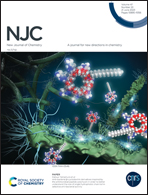Study of the removal of Pb(ii) and Ni(ii) from aqueous solution by new nano-Mg(OH)2/fly ash adsorbent materials
Abstract
In this paper, fly-ash-loaded nano-magnesium-hydroxide composites were prepared by the heterogeneous nucleation method based on the idea of “particle design” using fly ash as a raw material and MgCl2 and NaOH as reactive coating agents, and their performance in the adsorption of lead (2+) ions [Pb(II)] and nickel (2+) ions [Ni(II)] in mono- and binary systems was investigated. Scanning electron microscopy (SEM), EDS spectroscopy, X-ray diffraction (XRD), infrared spectroscopy (FTIR), X-ray photoelectron spectroscopy (XPS) and simulation equations were used for the characterization and analysis of the adsorption mechanism of the composite powder before and after adsorption. The results show that the physical and chemical properties of the modified fly ash are significantly improved. The problems of the low adsorption efficiency of fly ash as an adsorbent and the difficult separation of ash and water are successfully solved, as well as the problems of the slow settling and agglomeration of the colloidal solution of nano-magnesium hydroxide due to its small specific gravity and high surface energy. Through adsorption experiments using different systems, it is found that the composite powder has a strong adsorption effect on Ni(II) and Pb(II) in the unary system. In the binary competitive mixing system, the composite powder showed stronger selective adsorption of Pb(II), which may be related to the fact that the physical properties of Pb(II) are better than those of Ni(II). The adsorption isotherm of the overall adsorption process conforms to the Langmuir isothermal model. The maximum adsorption capacities of Pb(II) and Ni(II) reached 160.96 mg g−1 and 116.5 mg g−1 in the single system. The adsorption kinetics conform to the quasi-secondary kinetic model. The adsorption mechanism of the composite powder for Pb(II) and Ni(II) mainly involves precipitate adsorption, electrostatic adsorption, exchange interaction between cations and complexation between carbonate formed by the adsorption of CO2 from air and metal ions.



 Please wait while we load your content...
Please wait while we load your content...